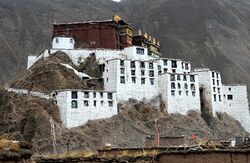Dorje Dzong
| Nation: | |
| Population: | ~51,000 |
| Predominant language: | Common tongue, Rulakan |
|
| |
| Main roads: | Rt 100 |
| Major districts: | |
|
| |
| Current mayor: | Kelzang Shatra |

| |
| Map versions: | |
Dorje Dzong was the third-largest city of Rulak (after Khimtsang and Marpo Guoxie respectively). The city was founded by some of the second-generation monks who had first settled Khimtsang. Established as a fortress to defend the island it was named the Dorje Dzong, or the Diamond Fortress, as the white stucco walls glinted like diamonds in the sun. Early in its history the island was subjected to frequent raids from Apollonia, the Dyre Islands, Norfolk, and even Eura. When the fortress was completed the High Lama ordered a hundred monks to train as warriors. These in turn trained more warrior monks so that soon the fortress grew into a vast military complex and a surrounding city to support it. The city suffered significant destruction when the communist revolution occurred and many loyalists defended it from the revolutionaries. Following the fall of the Soviet regime the city was restored with aid from Aryasht and new warrior monks trained along with a garrison from that country. With the collapse of Aryasht most Aryashti soldiers opted to remain, their families already being settled in the city, and Dorje Dzong became the center of the Rulakan military. Although now a modernized force, the military still maintains a significant command of warrior monks.
Geography
Dorje Dzong was located along the Micran equator and thus has an equatorial climate. The city was situated on a peninsula at the south-easternmost extremity of Rulak.
Climate
The city's climate falls within that of the Tropical rainforest climate with no distinctive seasons, uniform temperature and pressure, high humidity, and abundant rainfall. Temperatures usually range from 25 to 35 °C (77 to 95 °F). While temperature does not vary greatly throughout the year, there was a wetter monsoon season from November to January.